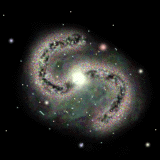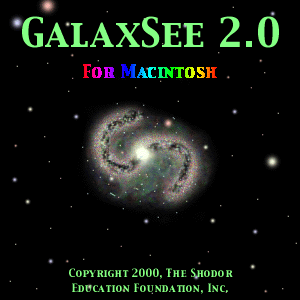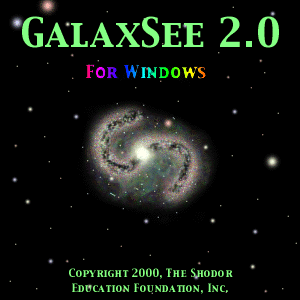
|
GalaxSee Development Page:
|
The purpose of this page is to store information regarding current progress
on the MASTER tool GalaxSee.
Development Goals:
-
Port GalaxSee to Windows
-
Increase force calculation options (improve speed and accuracy)
-
Increase integration options
-
Include color based perspective
-
Create "Point and Click" interface for creation and editing of input files
9-3-2001 (documentation included) - Click Here to download the latest version!
-
GalaxSee for Windows now stores many of your options when you shut down,
and uses them again the next time you start.
9-1-2001 (documentation included)
-
No more memory leaks! Some menu discrepancies between Mac and Windows
versions cleaned up.
5-15-2001 (documentation included)
-
New Chromadepth, Lots of new lesson plans, helper Excel spreadsheets, ~600K.
2-18-2001 (documentation included)
-
I've added trace features into the Windows version.
I still haven't cleaned up the images in the download package yet, so it's still a little big, though.
11-3-2000 (documentation included)
-
I've started bundling help files and example galaxies in with the executable.
The executable has had the ability to read old file types turned off until
some bugs can be fixed, but I'm working on it. The current download is a
little big, I haven't had a chance to crop down all of the images
for the help files down to a manageable size yet, there will be a smaller
release in the next few days. Until then, it's around 330K. As usual,
if it ain't broke, someone besides me wrote it. Um, I mean, let me know if
anything needs fixing.
8-26-2000
-
Thanks to Vik for taking over the Galaxy project for the summer, and good
luck at Union! A few minor bugs have been fixed in the latest release.
The proper velocity now shows up for the highlighted item in the star list.
There seems to be a few problems with reading in old GalaxSee files from
the Mac version, I'm working on fixing it. Watch out when loading old files
for a problem where the velocities shift by a factor of a 1000. If you
notice any unusual behavior, its probably a bug, not a feature, so email
me and let me know. -Dave J.
8-7-2000
-
The development of GalaxSee has been taken over by Vik Sangha. This is
the release of the newest beta version, which can be downloaded from here.
I have proceeded to add a notebook menu, which allows the user to view
individual star information and also provides the option to modify data
for a particular star. The info window has also been modified to show model
and energy data separately. There is also a newer version of the .gxy files
though older *.gxy files can still be opened and updated. I am presently
working on improving the chromadepth view and hopefully, we should be able
to view GalaxSee in 3-D soon.
6-3-2000
-
Energy has been broken into potential and kinetic for the display. An important
test has been made with spherical clusters. Spherical clusters with an
initial kinetic energy of - 1/2 the potential energy maintains its original
size, thus the code successfully reproduces the virial theorem. A lesson
based around this is being developed.
-
An option for a uniform density, spherical, non-interacting dark matter
component has been added to the galaxy creation options, though something
needs to be done to allow this info to be stored in a standard input file,
possibly as an option after all of the star data has been entered. The
energy calculation has been modified to reflect an equipotential surface
within the shield radius for each source.
-
The galaxy information display has been cleaned up, and shown in terms
of the current units. The code now keeps track of the number of iterations
per second.
-
Two new integration schemes have been added, an Adams-Bashforth-Moulton
method, modified to accept arbitrary grid spacing; and a Dynamic Euler
method, which is the improved Euler method from the older versions of GalaxSee
for Macintosh, which is there for comparison with older versions of GalaxSee.
There is some question about numerical stability in the formation of a
central core of stars, and the next step is to include an Aarseth style
integrator, in which each star gets its own time step. This modification
is well underway, the integration routine has been tested, and implementation
is expected soon. The ability to include parameters for a central mass
have been added to the galaxy creation process.
-
The Galaxy Info window has been added, but it needs the units to be more
prominently displayed. Currently all quantities are in MKS units. The "adaptive"
shield radius seems to not work so well for a high density of high mass
stars, perhaps some change needs to be made there, or give the user control
over the coefficients that set the dependency of the shield radius on mass
and time step. Windows are set to automatically size optimized for showing
both the galaxy and info on a 800X600 screen. The list of stars still needs
to be implemented. It might be useful to stop listing what has been made
similar with Mac and PC versions, and list what is currently different.
|
Mac
|
PC
|
| has stereo 3-D |
has ChromaDepth 3-D |
| has star list |
does not have star list |
| can read unformatted file |
requires formatted file |
| has Euler, improved Euler, and Leapfrog methods |
has Euler, Improved Euler, and Runge-Kutta 4 integration
methods |
| performs direct force calculation |
performs direct or Barnes-Hut force calculation |
| remembers settings from one use to another |
Does not remember settings from one use to another |
| Can zoom to center of galaxy |
can zoom to near center of galaxy |
| box is drawn with proper perspective |
box is not shaded, and overdraws stars even when they
are closer to the observer. |
-
OK, the big new thing now is that I've moved from a single window format
to a multiple window format. It is still set up to only run one model at
a time, but now I can display a model information window concurrently with
the galaxy model. Also, the galaxy resizes with the window. My change to
do this has introduced a little bug where when you zoom in, you shift (in
lateral directions) towards the center, I need to fix this. I've tried
to make control keys and menus look more like the Mac version, there are
a few weird menu problems though, resulting from the move to a multi-window
app. Dialog boxes to control the galaxy type, create the standard galaxy
shapes, control model running parameters, etc. have been added to bring
operation into accordance with the Mac version. Redshift has been added,
but I want to be able to graphically control color based on relative velocity,
or perhaps add a dialog box which allows the user to explore the velocity
structure of the galaxy. Finally, a bug was fixed in the Barnes-Hut force
calculation where tree elements at a large distance failed the shield radius
test, but individual elements within the tree did not.
-
ChromaDepth shading has been improved somewhat, it seems to bring out the
perspective better. I think in the long run, the trick is going to be to
add mouse drag control of depth options, and eventually redshift options,
similar to AIPS++ or some of the other FITS viewers, to allow the user
to bring out specific details. Points are sorted by distance so that points
which ar in front display in front. The menus have been updated a
bit. File opening and saving has been added, format is as on Mac, except
it currently expects a somewhat more rigorous format, requiring the number
of stars on the first line, and each star on one line thereafter (the Mac
version would accept a freeform format, though it was not recommended).
Colors can be specified in the file, and will display properly. The ability
to create a new galaxy has been added. Still needs user ability to adjust
model parameters though.
-
ChromaDepth shading is now a menu option, as is a variety of star colors
and point sizes. The points can be displayed as balls as well as squares.
A bug with zooming has been temporarily fixed by limiting the amount one
can zoom in.
-
I've been playing around with color. The demo here has ChromaDepth shading
on a black background hard coded, background color, star color, choice
of depth display options, all that cool stuff, still needs to be made menu
accessible, but it is starting to look like the Mac version, at least in
some rudimentary form. The Particle-Mesh force calculation still doesn't
work.
-
The drift with the Barnes-Hut algorithm seems to be fixed. The distance
at which the algorithm kicks in needed to be increased, so it was, which
cleared up another problem where the masses tended to clump along the center
of the nods in the main oct-tree. All is well now. Started to put
in a standard PM algorithm, which still needs some work.
1-18-2000
-
It's been a while since the last page update, what with Christmas, the
portal, and the AAS meeting, but here goes:
-
The Barnes-Hut Tree algorithm is being implemented, it doesn't really kick
in in terms of speed improvement until above 500 particles. 500 runs
at about the same speed independent of algorithm, but 5000, while slow,
will run with Barnes-Hut (at about 1 iteration per 5 seconds on my PC at
home), and just sits there and does nothing with a direct force calculation.
-
It's not quite debugged, there seems to be a bit of a drift in the center
of mass for some models.
-
Zooming and dragging functionality has been added, as well as the ability
to adjust the time step.
-
You can get the current version, with 500 particles
(hard-coded to run with direct force calculation) here.
-
The shield radius is computed for the force on mass A due to mass B as
-
SR=5*(GMB)1/3(Delta T)2/3
-
based on an order of magnitude estimate, where the error in the energy
is considered due to two factors, the error due to the difference between
a discrete and continuous solution, and the error due to the deletion of
the effects of gravity from within the shield radius.
12-13-99
-
Perspective has been added, as well as the ability to rotate the view either
through a dialog box with buttons, or by clicking on the view and dragging.
The amount of rotation is responsive to the speed of the mouse drag.
-
The viewing angle is stored as a quaternion, for ease of updating the viewing
angle. A general quaternion class has been created and introduced.
-
The 12-13 version has a Sol type star, with 3
planets, all hard-coded, and a reference box to improve the perspective.
-
What is currently missing? Currently, it is all black and white,
and eventually I am going to want to color code
-
things, at which point how things overlap will matter. Also, how things
fall in perspective to the box boundaries
-
will be important. So, how should it be ordered, and how should it be coded?
12-9-99
-
OK, the memory structure hasn't really been completely designed for multiple
bodies yet, I store things like the masses of the stars in weird places,
but plotting and computing of derivatives just assumes N bodies and goes
from there. An example (optimized for executable size, it's a little jumpy
though) is here.
12-8-99
-
A so beta it should really be called zeta test version is available. It
does not have a galaxy simulation.
-
It does have a coupled spring problem, with a driving frequency, and can
be downloaded from here.
-
Currently incorporated is
-
Diffeq class for computing evolution of coupled differential equations.
-
Dynamic class (extension of Diffeq) for treatment of N-body dynamic problems
in 3 dimensions.
-
Idle time processing
-
Double buffering to eliminate flickering in graphical display.
-
Menu control to start and stop model.
-
The same coupled spring problem has been treated as a JAVA applet, and
can be seen here.
-
recently added: the newest iteration is a gravitational problem, but only
with 2 bodies. The next step is to (a) up the number of bodies, (b) implement
some degree of perspective.
e-mail me at djoiner@shodor.org.
This page last updated on 8-7-2000.

